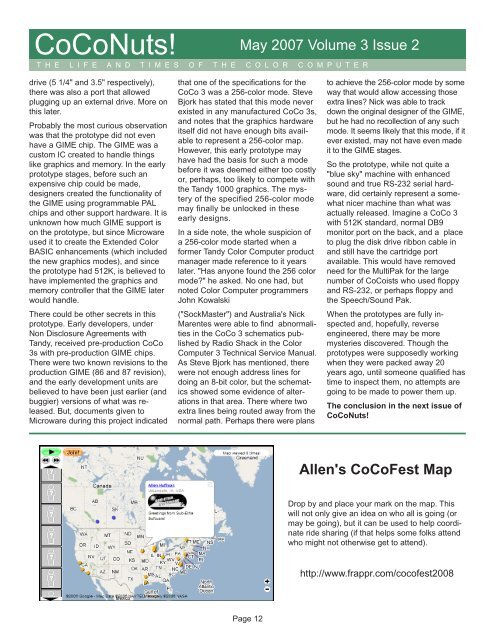Coco Nutz! Vol 3 Issue 2, May 2007.pdf - TRS-80 Color Computer ...
Coco Nutz! Vol 3 Issue 2, May 2007.pdf - TRS-80 Color Computer ...
Coco Nutz! Vol 3 Issue 2, May 2007.pdf - TRS-80 Color Computer ...
Create successful ePaper yourself
Turn your PDF publications into a flip-book with our unique Google optimized e-Paper software.
CoCoNuts! <strong>May</strong> 2007 <strong>Vol</strong>ume 3 <strong>Issue</strong> 2<br />
T H E L I F E A N D T I M E S O F T H E C O L O R C O M P U T E R<br />
drive (5 1/4" and 3.5" respectively),<br />
there was also a port that allowed<br />
plugging up an external drive. More on<br />
this later.<br />
Probably the most curious observation<br />
was that the prototype did not even<br />
have a GIME chip. The GIME was a<br />
custom IC created to handle things<br />
like graphics and memory. In the early<br />
prototype stages, before such an<br />
expensive chip could be made,<br />
designers created the functionality of<br />
the GIME using programmable PAL<br />
chips and other support hardware. It is<br />
unknown how much GIME support is<br />
on the prototype, but since Microware<br />
used it to create the Extended <strong>Color</strong><br />
BASIC enhancements (which included<br />
the new graphics modes), and since<br />
the prototype had 512K, is believed to<br />
have implemented the graphics and<br />
memory controller that the GIME later<br />
would handle.<br />
There could be other secrets in this<br />
prototype. Early developers, under<br />
Non Disclosure Agreements with<br />
Tandy, received pre-production CoCo<br />
3s with pre-production GIME chips.<br />
There were two known revisions to the<br />
production GIME (86 and 87 revision),<br />
and the early development units are<br />
believed to have been just earlier (and<br />
buggier) versions of what was released.<br />
But, documents given to<br />
Microware during this project indicated<br />
that one of the specifications for the<br />
CoCo 3 was a 256-color mode. Steve<br />
Bjork has stated that this mode never<br />
existed in any manufactured CoCo 3s,<br />
and notes that the graphics hardware<br />
itself did not have enough bits available<br />
to represent a 256-color map.<br />
However, this early prototype may<br />
have had the basis for such a mode<br />
before it was deemed either too costly<br />
or, perhaps, too likely to compete with<br />
the Tandy 1000 graphics. The mystery<br />
of the specified 256-color mode<br />
may finally be unlocked in these<br />
early designs.<br />
In a side note, the whole suspicion of<br />
a 256-color mode started when a<br />
former Tandy <strong>Color</strong> <strong>Computer</strong> product<br />
manager made reference to it years<br />
later. "Has anyone found the 256 color<br />
mode?" he asked. No one had, but<br />
noted <strong>Color</strong> <strong>Computer</strong> programmers<br />
John Kowalski<br />
("SockMaster") and Australia's Nick<br />
Marentes were able to find abnormalities<br />
in the CoCo 3 schematics published<br />
by Radio Shack in the <strong>Color</strong><br />
<strong>Computer</strong> 3 Technical Service Manual.<br />
As Steve Bjork has mentioned, there<br />
were not enough address lines for<br />
doing an 8-bit color, but the schematics<br />
showed some evidence of alterations<br />
in that area. There where two<br />
extra lines being routed away from the<br />
normal path. Perhaps there were plans<br />
to achieve the 256-color mode by some<br />
way that would allow accessing those<br />
extra lines? Nick was able to track<br />
down the original designer of the GIME,<br />
but he had no recollection of any such<br />
mode. It seems likely that this mode, if it<br />
ever existed, may not have even made<br />
it to the GIME stages.<br />
So the prototype, while not quite a<br />
"blue sky" machine with enhanced<br />
sound and true RS-232 serial hardware,<br />
did certainly represent a somewhat<br />
nicer machine than what was<br />
actually released. Imagine a CoCo 3<br />
with 512K standard, normal DB9<br />
monitor port on the back, and a place<br />
to plug the disk drive ribbon cable in<br />
and still have the cartridge port<br />
available. This would have removed<br />
need for the MultiPak for the large<br />
number of CoCoists who used floppy<br />
and RS-232, or perhaps floppy and<br />
the Speech/Sound Pak.<br />
When the prototypes are fully inspected<br />
and, hopefully, reverse<br />
engineered, there may be more<br />
mysteries discovered. Though the<br />
prototypes were supposedly working<br />
when they were packed away 20<br />
years ago, until someone qualified has<br />
time to inspect them, no attempts are<br />
going to be made to power them up.<br />
The conclusion in the next issue of<br />
CoCoNuts!<br />
Allen's CoCoFest Map<br />
Drop by and place your mark on the map. This<br />
will not only give an idea on who all is going (or<br />
may be going), but it can be used to help coordinate<br />
ride sharing (if that helps some folks attend<br />
who might not otherwise get to attend).<br />
http://www.frappr.com/cocofest2008<br />
Page 12

















